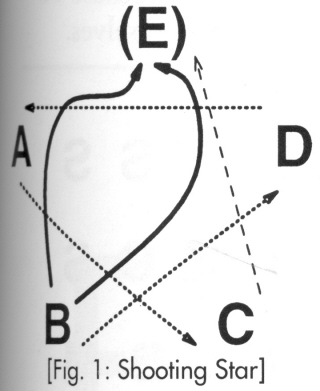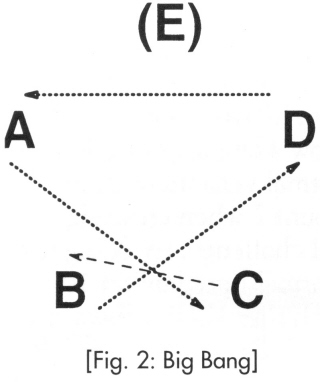|
Juggler's
Workshop
UNEXPECTED
PASSING by Martin Frost
Here are some unusual patterns that require a little stretch of the normal passing model. I hope that these ideas will provoke you into stretching or abandoning other standards of passing and thus into inventing patterns that you might not otherwise have thought of.
The
Shooting Star Revisited At
Stanford this summer, we came up with an unusual extension of the
Shooting Star. Remember that the Shooting Star (Juggler's Workshop, Fall 1994 ) is a five-person, nineclub star formation with one person missing (hence four people) and one person starting with no clubs. Fig. 1 shows the pattern.
Juggler
C starts with no clubs, and juggler E didn't show up. The dotted lines
show where the passes go. The solid lines show two possible routes for
juggler B to take to get to E's
The
basic pattern uses nine
clubs, but you can give one or two clubs
to the person who otherwise would have no clubs initially (C in
the figure), for a total of
ten or eleven. Then you run to a new spot, not when you're out of
clubs, but when you're down to as many clubs as C started with (one
With
ten clubs, after every other pass someone runs, but with eleven clubs,
after every pass someone is running - so each person runs every few
seconds. That's a lot of running and you can get tired quickly (well,
we did), so I decided that it would be nice to be able to keep the
eleven-club pattern going but allow people to take a break from
running now and then. This leads us to the Big Bang, which allows
arbitrary resting time.
The
Big Bang We
start with an 11-club Shooting Star, but whenever it's your turn to
run, you can choose to run or you can choose to stay put. If you stay
put, then we have the Big Bang (we'll see why it's called that!). The
person who normally passes to you still does. But that pass, instead
of being a regular star pass becomes a "funky" pass, which
as you might guess is a little odd. Fig. 2 shows the formation that
results if B in Fig. chooses not to run. C is
There
is one major impediment to the funky pass from C to B, namely the pass
from A to C. To avoid hitting that club coming from A, C should turn
to face B and then pass from
way inside to a nice high spot on B's left. Until you turn
to face B, you can pass from way inside (essentially from your left
side with your R hand) and under your left arm. The idea is simply to
keep your passes to B outside of the channel that Ns passes are
taking to you.
Also,
don't throw late or you'll really be in trouble. However, don't throw
early either, because you actually have a second club to avoid, namely
B's pass to D. Throw high and lofty, both to avoid that club and to
allow for the fact that your pass to B is shorter than the other
passes in the star.
After
a few unsuccessful tries at avoiding those two potential collisions
(while maintaining the star rhythm carefully to avoid the usual
potential star collisions!), you may think you understand why it's
called the Big Bang!
But
actually, there is an even better reason. Once you actually master the
pattern, you'll notice, especially if you're in D's position, a very
interesting visual effect: Three clubs seem to come into being at
once, all heading out in different directions from one spot - the Big
Bang of club creation.
To
learn the Shooting Star you don't actually have to do the Shooting
Star. In fact, of course, you can do the Big Bang with twelve (or
more!) clubs and no hole (if you're not shooting). But if you want to,
you can go back and forth between the two eleven-club patterns, simply
on the whim of individuals deciding whether or not to shoot the star
(to run, that is). It is a bit tricky to instantly have to adjust your
throw, if you're in C's position and don't know where B is going to
be. But
Oh,
one more thing, after you have chosen not to run, you can't resume
running until the hole gets back around to you, since you normally run
as the (last) hole is being thrown to you. Your partners can shorten
this wait quite a bit by passing the hole immediately each time one of
them gets it instead of keeping the hole in its original spot in the
sequence of clubs. When you are finally about to run again, it's
probably best to let your partners know that you're going, although
this isn't strictly necessary if you leave as a hole is passed to you.
The nice thing is that you now can take a breather whenever you want
in the 11-club Shooting Star. Have fun.
Jim's
Jam This
extreme (but not physically demanding) two-person six-club pattern was
created by Jim Brennan of Lincoln, Nebraska. I learned it from Steve
Otteson in Rapid City this summer, along with a nice variation. The
idea in Jim's Jam is that each hand, in turn, feeds all the hands,
including itself.
Your
right hand feeds all four hands, then your left does the same. In
addition to the four throws to the four hands, there is one additional
self which is necessary in order to get a club to your feeding hand.
That makes a total of five throws in each half of the pattern. The two
jugglers are doing the same things at the same times. Here's the first half of the throw sequence:
|

